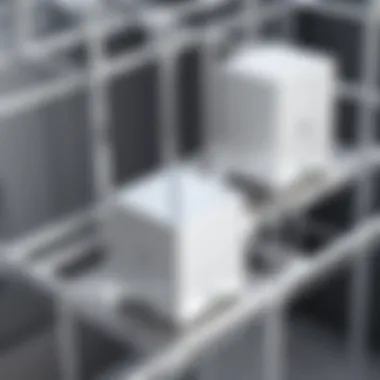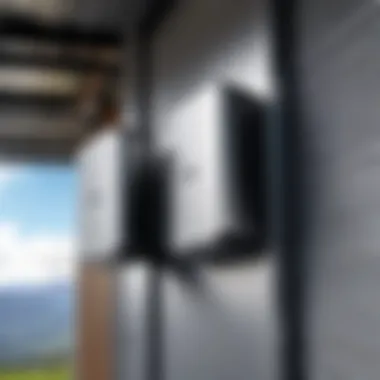Top Wifi Extenders for Metal Buildings Revealed


Intro
Metal buildings present unique challenges for wireless signals. Their construction materials can obstruct or interfere with Wi-Fi signals, making it difficult to maintain a strong connection throughout the space. Understanding how to extend Wi-Fi effectively in such environments is crucial for IT professionals and tech enthusiasts. This article targets those seeking reliable solutions to bolster their internet access in metal structures. We will examine essential hardware aspects, explore software features, and analyze performance metrics that play a key role in ensuring a seamless online experience.
Hardware Overview
When considering the best Wi-Fi extenders for metal buildings, hardware specifications are critical. The most effective devices typically feature high-gain antennas, dual-band functionality, and robust processing power to navigate the interference caused by metal walls.
Specifications
- Frequency Bands: Many extenders operate on both 2.4 GHz and 5 GHz bands. The 2.4 GHz band offers a broader range, while the 5 GHz band provides faster speeds, important for reducing lag.
- Antenna Quality: Omnidirectional antennas are often more effective in distributing Wi-Fi signals evenly throughout a building.
- Ports and Connectivity: Look for extenders with Ethernet ports for wired connections to ensure stable performance for devices that require high-bandwidth usage.
- Range: Consider devices with a maximum coverage significantly exceeding typical residential extenders. This ensures connectivity is maintained in larger metal spaces.
Performance Metrics
The performance of a Wi-Fi extender can be assessed through several key metrics:
- Data Transfer Speeds: Higher speed ratings can affect load times and streaming quality.
- Latency: Minimized lag is critical for online tasks, especially in professional environments.
- Throughput: This refers to the maximum amount of data transmitted successfully over a time period.
- Signal Strength: The ability of the extender to maintain a robust signal throughout the building will dictate overall effectiveness.
"Selecting the correct hardware is essential to overcoming the inherent limitations of metal building construction."
Software Analysis
While hardware plays a significant role, software features can greatly enhance the overall user experience and system efficiency.
Features and Functionality
Good Wi-Fi extenders also come loaded with user-friendly features:
- Easy Setup Procedures: Many devices offer app-based setup, simplifying installation.
- Network Management Tools: Some extenders provide network optimization features. These ensure that devices are connected efficiently without congesting the available bandwidth.
- Firmware Updates: Regular software updates can improve existing features and security, vital in a world where connectivity is critical.
User Interface and Experience
A clear and intuitive interface is essential:
- Users should be able to navigate settings with ease.
- Visual indicators for signal strength can assist in placement decisions during installation.
- Remote management options allow users to control the network without being physically present.
In summary, selecting the best Wi-Fi extender for a metal building requires careful consideration of both hardware and software. Ensuring strong connectivity involves an understanding of specifications, performance metrics, and usability features. With the right tools and knowledge, maintaining a reliable online experience in challenging environments is certainly achievable.
Understanding the Challenges of Wifi Connectivity in Metal Buildings
In metal buildings, the challenge of Wifi connectivity comes with unique complexities. Understanding these challenges is crucial for effective networking solutions. Metal structures can interfere with wireless signals. This interference can lead to dead zones and inconsistent connection speeds. Recognizing these issues allows IT professionals and tech enthusiasts to make informed choices when selecting Wifi extenders.
Impact of Metal Structures on Signal
Metal is notorious for disrupting Wifi signals. The fundamental issue lies in how metal reflects, absorbs, and refracts radio waves. When devices transmit signals, they pass through layers of solid materials. In a metal building, these layers hinder the signal's ability to propagate effectively.
Research indicates that a signal can lose about 90% of its strength when passing through a metal surface. This drastic reduction means areas within the metal structure may experience poor connectivity. Hence, choosing equipment specially designed to overcome this interference is vital. The right extender can effectively amplify and propagate Wifi signals, providing a more reliable network.
Common Issues Faced
Several issues arise in the quest for stable Wifi in metal buildings:
- Signal Dead Zones: Certain areas within the structure may receive little to no signal. This impedes access to essential online services, relying on connectivity for productivity.
- Decreased Speed: Even if a signal is present, the speed might fluctuate significantly. Users may experience buffering during video calls or delays in downloading files.
- Limited Range: The typical range of standard Wifi devices tends to shorten significantly in metal buildings. Thus, users find themselves confined to just a few areas with strong connectivity.
- Connectivity Drops: Inconsistent performance can lead to online frustrations, especially for remote workers who depend on continuous access.


Addressing these common issues with adequate solutions is necessary to maintain productivity. By recognizing the specific challenges in metal settings, the suitable Wifi extender can be selected. This is essential for achieving seamless internet access.
Criteria for Selecting a Wifi Extender
When discussing the best Wifi extenders for metal buildings, it is crucial to understand the criteria for selecting an appropriate device. In such environments, the unique challenges presented by metal structures necessitate specific considerations. These criteria help ensure that the extenders provide optimal coverage, speed, and compatibility, as well as accommodate the building’s layout and usage needs.
Range and Coverage Area
The range and coverage area of the Wifi extender determines how much space the device can effectively serve. In metal buildings, signals often encounter significant obstacles due to interference from metal walls. It is important to choose an extender that can cover a greater distance than typical models, as the signal may weaken considerably over distance. Look for devices that offer dual-band functionality, since this can improve overall coverage by distributing signals effectively across various frequencies. A device with a range capability exceeding 300 feet is advisable for substantial coverage.
Furthermore, users should consider the layout of the building. If there are multiple rooms or floors, a Wifi extender that can cover vertical and horizontal distances efficiently should be prioritized.
Speed and Performance Metrics
Speed and performance metrics are paramount when evaluating a Wifi extender. Metrics such as Mbps or Gbps give insight into the maximum theoretical speed the device can handle. In metal buildings, where interference is common, it is important to pick extenders that maintain high speeds even under load. Look for extenders that support the latest Wi-Fi standards, such as Wi-Fi 6, as they provide not only higher potential speeds but improved efficiency in managing multiple connected devices. Users should assess if the extender has features like beamforming, which delivers a focused signal in the direction of the connected devices. This can greatly enhance the performance especially in environments with metal interference.
Compatibility with Existing Equipment
The compatibility of the Wifi extender with existing networking equipment cannot be overlooked. This includes routers, access points, and other networking devices. Ensuring that the extender is compatible with the current network standards is crucial for smooth integration and performance. Some extenders work best only with specific brands or technologies; therefore, checking compatibility details beforehand can ease installation and functionality later. Additionally, look for extenders that offer easy setup options, whether through a mobile application or a web-based interface, to streamline the connection process. These aspects will significantly influence the user experience post-installation.
Top Wifi Extenders for Metal Buildings
Selecting the right Wifi extender is pivotal when navigating the complexities of metal buildings. The dense materials in these structures can drastically reduce signal strength, leading to dead zones and unreliable connectivity. Identifying extenders that are specifically designed for such environments will not only improve the range but also enhance speed. This section delves into top-rated extenders that can overcome the inherent challenges of metal buildings, ensuring a robust and stable internet connection.
Extender A: Features and Specifications
Extender A is designed with dual-band technology, offering both 2.4GHz and 5GHz frequencies. This feature is important as it allows devices to connect to the optimal band for improved performance. It supports up to 1200Mbps, which is sufficient for most internet activities including streaming and gaming. The device also includes advanced MIMO technology, improving signal to multiple devices simultaneously. Additionally, the dual antennas help in extending the reach of the Wifi signal, which is critical in a metal building where interference can be high.
Key Features:
- Dual-Band Support: Operating on both 2.4GHz and 5GHz.
- Speed: Up to 1200Mbps for efficient data transfer.
- MIMO Technology: Allows for multiple streams.
- Dual Antennas: Enhances signal reach and strength.
Extender B: Performance Analysis
In terms of performance, Extender B has received positive feedback from users who live or work in metal buildings. It features beamforming technology, which focuses the Wifi signal directly towards connected devices rather than spreading it uniformly. Test results indicate a 30% improvement in signal strength compared to standard extenders in dense environments. Users have reported noticeable improvements in upload and download speeds, crucial for tasks such as video conferencing and large file transfers. The extender’s ability to automatically select the best channel also reduces interference from other nearby networks.
Extender C: User Experience
User experience with Extender C has been largely favorable. The installation process is user-friendly, allowing even those with limited technical knowledge to set it up quickly. Many users appreciate the clear LED indicators, which signal the strength of the connection at a glance. Most importantly, the extender maintains a stable connection over time, which is vital in environments prone to interference. Additionally, customer support for the device is well-rated, providing users with the assistance they need to troubleshoot common issues effectively.
User Insight: "Since installing Extender C, my signal strength on the far end of the metal building has improved significantly. Video calls are smoother, and I can finally stream without buffering."
By examining these extenders, it becomes clear that careful selection based on features, performance, and user experiences is essential for users looking to enhance their Wifi connectivity in metal buildings.
Technology Behind Wifi Extenders
Understanding the technology behind Wifi extenders is crucial for effectively addressing connectivity issues in metal buildings. Metal structures significantly impede wireless signals due to their reflective and absorbent properties. Therefore, choosing the right extender involves grasping not just how Wi-Fi signals operate but also the specific features that enhance their performance in a challenging environment.
Types of Wifi Extenders
Wifi extenders come in several types, each designed for different conditions. Here are the primary types you might encounter:
- Standard Wifi Extenders: These amplify the signal from a router to provide extended coverage. They are most effective in open areas but face challenges in metal buildings.
- Powerline Adapters: This type uses existing electrical wiring to transmit data. They are particularly useful when the distance between the router and the area needing coverage is considerable, or when walls obstruct the signal.
- Mesh Systems: Comprising multiple units working in tandem, mesh networks offer a more holistic approach to coverage. They maintain a single network name and manage data intelligently, making them suitable for larger or more complex metal buildings.
When selecting an extender, consider how each type interacts with your unique environment and existing setup.


Packet Data Transmission
Packet data transmission is another vital component of Wifi technology. It refers to how data is divided into packets for efficient transmission over networks. This transmission method is key for maintaining speed and reliability in wireless communication.
In environments characterized by metal structures, packet loss can occur when signals encounter obstructions. This can result in slower speeds and interrupted service. To mitigate these issues, modern Wifi extenders often utilize technologies such as:
- Beamforming: This focuses the signal directly towards the connected device instead of broadcasting uniformly. It improves the quality and strength of connections in environments where obstacles exist.
- Dual-Band Technology: Most extenders now support both 2.4 GHz and 5 GHz bands. This flexibility allows for better management of network traffic, enabling devices to switch to the optimal band based on distance and congestion.
Understanding these technical elements is essential for IT professionals and tech enthusiasts. It ensures informed decisions when selecting an effective Wifi extender, particularly in complex environments like metal buildings.
Installation Considerations
In the context of wifi extenders, installation plays a crucial role in ensuring optimal performance, especially for metal buildings. Metal structures can significantly hinder wifi signals due to their density and reflective properties. Thus, understanding installation considerations becomes vital in overcoming these challenges. The right setup can enhance connectivity and provide a reliable internet experience.
Optimal Placement for Maximum Coverage
Placement of the wifi extender is one of the most critical factors for achieving optimal coverage. In metal buildings, the aim is to position the extender in a location where signal disruption is minimized. A strategic approach is required.
- Central Location: Choose a spot that is central to the area where the signal is being used. This can often mean placing the extender halfway between the router and the area of low signal strength.
- Height Matters: Elevating the extender can help; placing it on a shelf or mounting it higher on the wall can lead to better signal propagation.
- Avoiding Obstacles: Ensure that the extender is kept away from metal objects, appliances, or thick walls. These can absorb or block the signal, degrading performance.
- Testing Signal Strength: Use a smartphone or laptop to assess signal strength in various areas. This can guide adjustments to the extender's position.
Connecting the Extender to Your Network
Setting up the wifi extender correctly is essential for effective operation. The first step is connecting it to your existing network.
- Using WPS: Many modern extenders support WPS, which allows for quick and easy connection by pressing a button. If your router also supports WPS, this method can save time.
- Manual Setup: If WPS is unavailable, manual setup requires connecting to the extender’s network via a device and using a browser to enter the configuration details. Most extenders provide a straightforward interface for network setup.
- Network Name and Password: Make sure to enter the right SSID and password for your existing wifi network. Consistency will help devices switch seamlessly between the router and extender.
- Firmware Checks: Lastly, ensure the firmware of the extender is up to date. Manufacturers often release updates to enhance compatibility and performance.
> Following these guidelines for placement and connectivity can greatly improve your overall wifi experience, particularly in challenging environments like metal buildings.
Assessing Performance Post-Installation
After installing a Wifi extender in a metal building, the real work begins: ensuring it performs optimally. Assessing performance post-installation is crucial. It helps identify how well the extender is working and if it meets your connectivity needs. This assessment can ensure that all devices maintain a strong and stable connection.
In metal buildings, where interference and signal attenuation can occur, understanding the extender’s performance is essential. Factors like coverage strength, data transfer rates, and latency should be evaluated. Neglecting this step could lead to continued connectivity issues, which defeats the purpose of using a Wifi extender in the first place.
> "Regularly assessing your Wifi extender's performance ensures that you are getting the best possible service from your investment."
Measuring Signal Strength
To measure signal strength, one can use various tools and applications. Many routers and extenders come with built-in diagnostic tools, which are useful. Third-party apps such as NetSpot and Wi-Fi Analyzer can provide detailed insights into signal strength across your space.
When measuring, check these key variabls:
- Signal-to-noise ratio (SNR): A high SNR indicates a cleaner signal.
- Received signal strength indicator (RSSI): This is a measurement of the power level that a device receives.
- Connection quality metrics: These can show how many packets lose their way between devices.
Position measurements at different areas will uncover weak spots in your coverage. This information helps in adjusting the extender's position or considering hardware upgrades if needed.
Identifying Bottlenecks
Finding and identifying bottlenecks is the next critical step in assessing performance. After measuring signal strength, look for areas where data speeds are unusually slow. Network congestion and interference from other devices can often cause these bottlenecks. A good approach is to use bandwidth monitoring tools.
Consider these points as you evaluate your network:
- Device limitations: Check if any devices are not capable of handling higher speeds offered by the extender.
- Channel utilization: Analyze if the extender operates on a crowded channel. Switching to a less crowded channel can improve performance.
- Internet service provider restrictions: Sometimes, the issue isn't the extender at all; it could be due to limitations from your Internet service provider.
Troubleshooting Common Issues


Troubleshooting common issues is vital for maximizing the potential of Wifi extenders in metal buildings. The unique challenges posed by metal structures often lead to unexpected connectivity problems. By understanding and resolving these issues, users can significantly enhance their network performance and ensure reliable internet access throughout their space.
Interference from Other Devices
One major factor that disrupts Wifi signals in metal buildings is interference from other electronic devices. These can include microwaves, cordless phones, Bluetooth devices, and even neighboring Wifi networks. Such interference can lead to slow speeds, dropped connections, and inconsistent performance.
To minimize interference, consider the following steps:
- Identify Sources: Recognize devices that emit signals in the same frequency range as your extender. Typically, this includes 2.4GHz and 5GHz bands.
- Relocate Devices: If possible, move conflicting devices away from your Wifi extender. For example, placing your extender further from a microwave can help improve signal clarity.
- Change Frequency Band: If your extender supports dual-band, switch to 5GHz where possible. This band is usually less congested, offering better performance in environments with multiple signal sources.
By taking these actions, users can often rectify interference issues.
Resetting and Reconfiguring the Extender
Sometimes, despite careful setup, a Wifi extender may falter. Resetting and reconfiguring the unit can often restore functionality. This process not only clears any potential software glitches but also ensures that the device is operating optimally.
Here’s how to effectively reset and reconfigure your extender:
- Locate Reset Button: Most extenders have a reset button. Press this button for about 10 seconds. This will revert the device to factory settings.
- Reconnect to Your Network: After resetting, using the initial setup process, connect your extender to your existing network. This often involves accessing the device's interface through a web browser.
- Follow Setup Instructions: Follow the on-screen prompts to reenter your network name and password. Ensure you configure any additional settings required for your environment.
- Test Connectivity: Once reconfigured, test the extender's performance. This should include checking signal strength in various locations within the metal building.
This method ensures that any corrupted data or conflicting settings are cleared, allowing for improved performance.
"Resetting your Wifi extender can often solve various connectivity issues, restoring stability to your network."
Understanding and applying these troubleshooting methods can significantly affect your experience with Wifi extenders in metal buildings. The outcome depends on clear identification of issues and their prompt resolution, ensuring optimal connectivity.
Future Trends in Wifi Extender Technology
The landscape of Wi-Fi extenders is evolving rapidly, reflecting the ongoing advancements in technology. This evolution is especially pertinent in the context of metal buildings, where connectivity challenges are pronounced. Understanding future trends will help both IT professionals and tech enthusiasts to select extenders that not only meet current needs but also adapt to future demands.
Advancements in Mesh Networking
Mesh networking is gaining significant traction as a superior solution for enhancing Wi-Fi connectivity, particularly in complex environments like metal buildings. Unlike traditional extenders that merely amplify an existing signal, mesh systems consist of multiple interconnected devices that create a seamless network.
The core advantage of mesh networking lies in its ability to cover larger areas more effectively. Each node in a mesh network communicates with one another, thus reducing dead zones and improving overall network reliability. This is critical in metal buildings where signal attenuation can result in uneven coverage. Considerations for selecting mesh systems include:
- Node Compatibility: Ensure that nodes can communicate efficiently.
- Scalability: Future expansions should be seamless with additional nodes.
- User Interface: An intuitive app can greatly enhance user control over the network.
Moreover, with the increasing number of connected devices in homes and businesses, a mesh network can adapt to fluctuating demands, allocating bandwidth intelligently and ensuring consistent performance.
Increasing Role of AI in Network Optimization
Artificial intelligence is set to revolutionize how Wi-Fi extenders operate, making them smarter and more adaptable. AI can assist in optimizing network performance through real-time analytics and automated adjustments based on usage patterns.
Some potential applications of AI in Wi-Fi technology include:
- Self-Optimization: AI algorithms can analyze data traffic and automatically adjust settings like channel selection and bandwidth allocation.
- Predictive Maintenance: AI can identify potential issues before they affect users, prompting proactive service adjustments.
- User Behavior Insights: By studying how users interact with the network, AI can ensure priority access for essential devices.
The integration of AI into Wi-Fi extenders promises not only to enhance connectivity but also to improve the overall user experience by simplifying management and troubleshooting processes.
"As technology advances, embracing trends in Wi-Fi extender technology is essential for ensuring robust connectivity in challenging environments such as metal buildings."
Ending
In the realm of achieving reliable Wifi connectivity in metal buildings, selecting the appropriate Wifi extender holds significant importance. Metal structures inherently disrupt signal strength and quality, leading to challenges in maintaining a stable internet connection. Thus, ensuring the choice of a quality Wifi extender is not merely a technical necessity but a fundamental requirement for effective communication and operational efficiency in such environments.
The benefits of utilizing an adept Wifi extender extend beyond mere signal amplification. Firstly, the right extender can enhance data transfer rates significantly, facilitating smoother workflows. This is especially crucial for IT professionals and tech enthusiasts who rely on uninterrupted internet access for their tasks. Secondly, a well-chosen extender optimizes the overall network performance, mitigating issues related to lag and buffering, which can be detrimental to productivity.
Several considerations emerge when finalizing a selection. Factors like coverage area and compatibility with existing hardware must be evaluated meticulously. Furthermore, understanding the specific requirements of the building and the number of users is critical in determining the appropriate model. Taking the time to assess these parameters aids in navigating the complexities often associated with metal buildings.
Ultimately, the knowledge gained from this article serves to guide readers through the intricate decision-making process involved in choosing a Wifi extender. The insights provided aim to support the establishment of reliable connectivity, thereby enhancing overall satisfaction and productivity in environments where metal structures present unique challenges.



